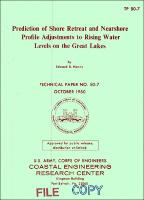Please use this identifier to cite or link to this item:
https://hdl.handle.net/11681/22181| Title: | Prediction of shore retreat and nearshore profile adjustments to rising water levels on the Great Lakes |
| Authors: | Hands, Edward B. |
| Keywords: | Beach erosion Great Lakes (North America)--Water level |
| Publisher: | Coastal Engineering Research Center (U.S.) |
| Series/Report no.: | Technical Paper (Coastal Engineering Research Center (U.S.)) ; no. TP 80-7 |
| Abstract: | Abstract: The effects of water level changes on shore recession are particularly important in the Great Lakes because annual mean lake levels often rise rapidly for periods of 5 to 10 years and then decline for a similar number of years. To a limited extent, man can anticipate and influence these fluctuations. Two methods of predicting the response of a beach to such fluctuations are (a) by measuring rates of shore change at certain locations during and after a recent rise in the water surface elevations, and assuming the next change in water level will illicit a similar response, or (b) by balancing sediment gains and losses in a manner that would adjust an equilibrium profile to the new water level. The first method entails a qualitative evaluation of differences in lake level behavior and geomorphic conditions between the study site and the site of application. If mean water levels are predicted to remain at their new elevation long enough for complete profile adjustment, then the second method (sediment balance approach) should be used. The latter approach also accounts for site-specific variations. Shore recession in response to higher mean water levels involves adjustments which affect a broad area of the nearshore zone. The sediment balance approach provides a realistic model for evaluating the ultimate response of both the shoreline and the nearshore zone to a quasi-permanent change in water levels. This fact was verified by measurements of profile change between 1967 and 1976 along a section of the eastern shore of Lake Michigan. This data set also permitted an evaluation of the timelag between lake level changes and profile readjustment. A relationship between the maximal depth of profile adjustment and the wave climate is proposed which will facilitate application of these results to other locations throughout the Great Lakes. |
| Description: | Technical Paper |
| Gov't Doc #: | TP 80-7 |
| Rights: | Approved for public release; distribution is unlimited. |
| URI: | http://hdl.handle.net/11681/22181 |
| Appears in Collections: | Technical Paper |
Files in This Item:
| File | Description | Size | Format | |
|---|---|---|---|---|
| TP 80-7.pdf | 22.93 MB | Adobe PDF |  View/Open |